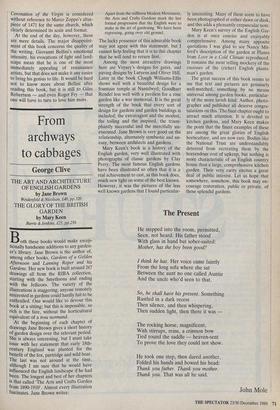From archways to cabbages
George Clive
THE ART AND ARCHITECTURE OF ENGLISH GARDENS by Jane Brown
Weidenfeld & Nicolson, .£40, pp.320
THE GLORY OF THE BRITISH GARDEN by Mary Keen
Barrie &Jenkins, 125, pp.256
Both these books would make excep- tionally handsome additions to any garden- er's library. Jane Brown is the author of, among other books, Gardens of a Golden Afternoon and Lanning Roper and his Gardens. Her new book is built around 267 drawings all from the RIBA collection, starting with the Smythsons and ending with the Jellicoes. The variety of the Illustrations is staggering; anyone remotely interested in gardens could hardly fail to be enthralled. One would like to devour this book at a sitting; but this is impossible, so rich is the fare, without the horticultural equivalent of a trou normand.
At the beginning of each chapter of drawings Jane Brown gives a short history of garden design over the relevant period. She is always interesting, but I must take issue with her statement that early 18th- century England was planted for the benefit of the fox, partridge and wild boar. The last was not around at the time, although I am sure that he would have influenced the English landscape if he had been. The longest and best of her chapters is that called 'The Arts and Crafts Garden from 1890-1910'. Almost every illustration fascinates. Jane Brown writes:
Apart from the stillborn Modern Movement, the Arts and Crafts Gardens mark the last formal progression that the English were to make in the art of gardening. We have been regressing, going over old ground.
The lucky possessor of this admirable book may not agree with this statement, but I cannot help feeling that it is to this chapter that he will tend to return first.
Among the most attractive drawings here are Voysey's designs for gates, and paving designs by Lutyens and Oliver Hill. Later in the book Clough Williams-Ellis shows well with a beautiful design for a fountain temple at Nantclwyd; Goodhart Rendel less well with a pavilion for a rose garden like a war memorial. It is the great strength of the book that every sort of design for gardens and garden buildings is included; the extravagant and the modest, the toiling and the inspired, the trium- phantly successful and the mercifully un- executed. Jane Brown is very good on the relationship, alternately symbiotic and un- easy, between architects and gardens.
Mary Keen's book is a history of the English garden, very well illustrated with photographs of classic gardens by Clay Perry. The most famous English gardens have been illustrated so often that it is a real achievement to cast, as this book does, much new light on some of the best known. However, it was the pictures of the less well known gardens that I found particular-
ly interesting. Many of them seem to have been photographed at either dawn or dusk, and this adds a pleasantly crepuscular note.
Mary Keen's survey of the English Gar- den is at once concise and enjoyably comprehensive. Among many apposite quotations I was glad to see Nancy Mit- ford's description of the garden at Planes from Love in a Cold Climate reproduced. It remains the most telling mockery of the excesses of the (richer) English plants- man's garden.
The great success of this book seems to me that text and pictures are genuinely well-matched, something by no means universal among garden books, particular- ly of the more lavish kind. Author, photo- grapher and publisher all deserve congra- tulations on this. The final chapter ought to attract much attention. It is devoted to kitchen gardens, and Mary Keen makes the point that the finest examples of these are among the great glories of English horticulture, and are now rare. Bodies like the National Trust are understandably deterred from recreating them by the horrendous cost of upkeep, but nothing is more characteristic of an English country house than a large, comprehensive kitchen garden. Their very rarity excites a great deal of public interest. Let us hope that somewhere, somehow, this book may en- courage restoration, public or private, of these splendid gardens.










































































































 Previous page
Previous page